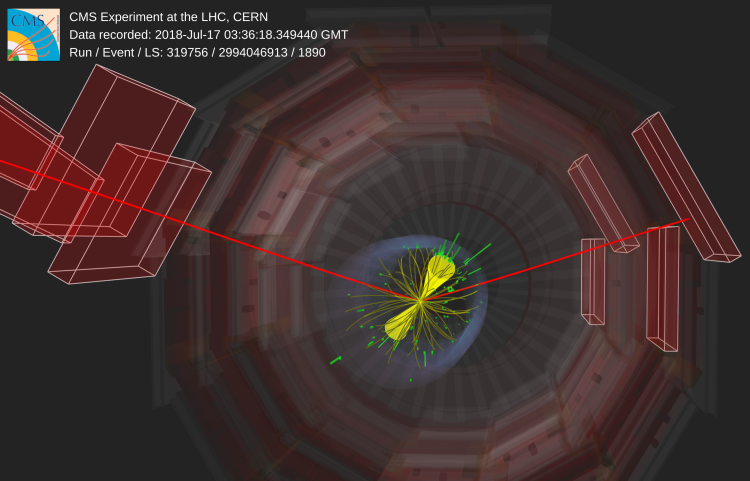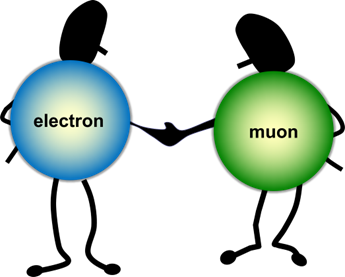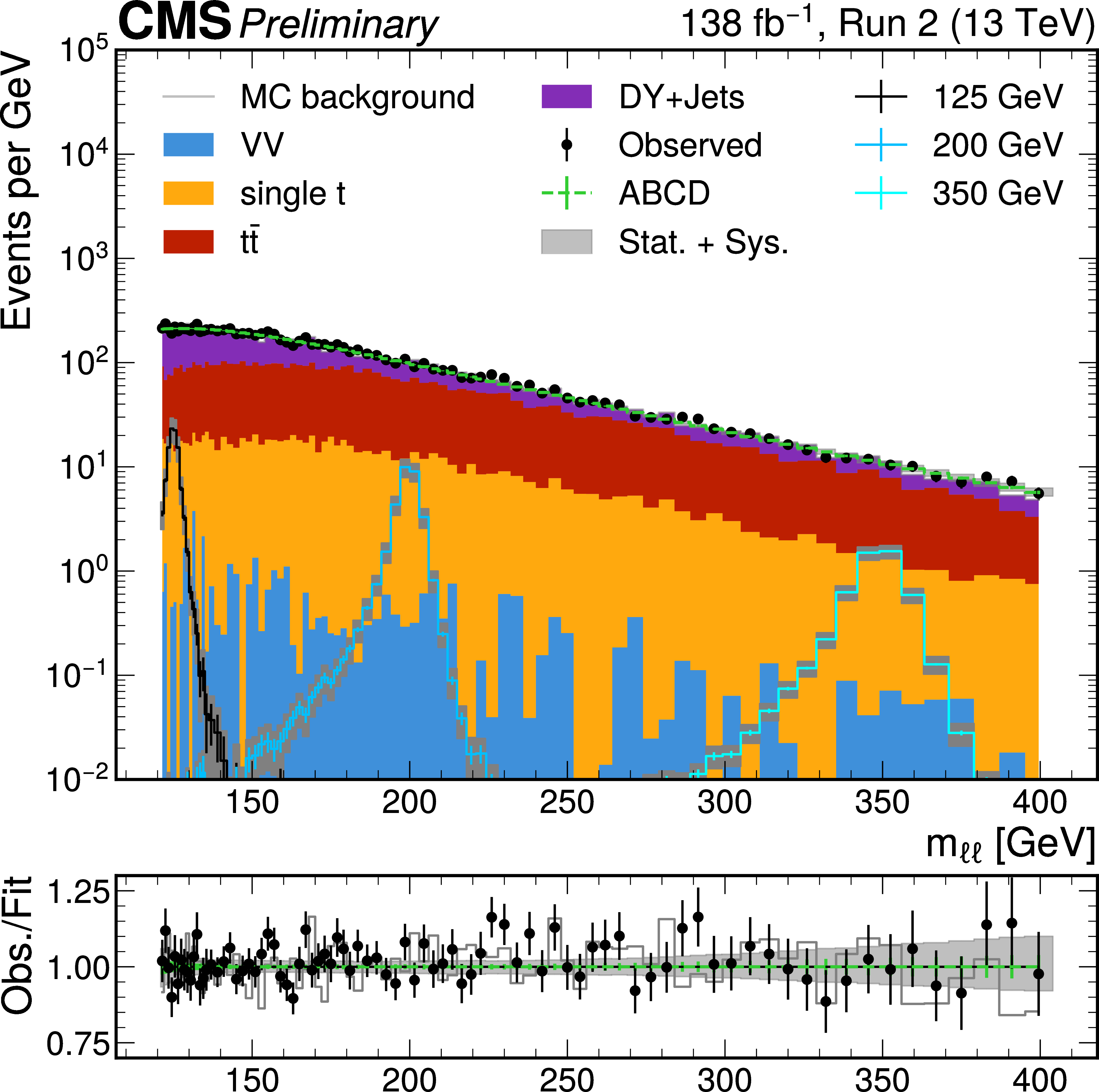
In the world of elementary particles, there are twelve generic types of fermions (spin ½ particles): 3 up-type quarks, 3 down-type quarks, 3 charged leptons, and 3 neutrinos. They come in three generations. The number “3” is really a magic number here. Particles of the same type behave the same across all their generations, except for having different masses. This is the current description in the standard model (SM) of elementary particles, a framework which describes a wide range of phenomena and yields some of the most precise predictions in physics. But we may be seeing hints that this generational particle equality, called universality, may not be entirely true.
Bosons (integer-spin particles) are the messengers during interactions between fermions and each other. The weak bosons, W and Z, were discovered at CERN near Geneva in Switzerland in 1981. Weak bosons can decay without preference into fermion pairs, such as electron or muon pairs (corresponding to the 1st- and 2nd-generation of charged leptons) (Fig. 1). Each Z boson decays into an electron (e-) and a positron (e+) at the same rate as it would into a negatively-charged muon (μ-) and a positively-charged muon (μ+). The world seemed perfectly equal.

Figure 1: Illustration of an electron and a muon that are equally treated in the standard model.
However, small imbalances in interaction rates are reported in the decays of a B-meson to muons vs tau leptons. This might be a hint that nature is not so equal after all, and a new particle beyond the SM framework might be what causes this. One such particle candidate is a heavy neutral boson, called a Z'. It is a heavier partner of the Z boson but decaying preferably into a pair of μ- and μ+, instead of a pair of e- and e+.
CERN’s Large Hadron Collider might be able to produce such new particles in powerful proton-proton (pp) collisions. We examined ~1016 pp collisions using a super-fast particle detection “camera”, called the Compact Muon Solenoid (CMS). What do we search for? A new Z' particle (of mass between 120 GeV and 350 GeV) that prefers muons over electrons. It also has a distinct preference for bottom quarks and may have some occasional rendezvous with strange quarks, as well. It is a bit of a snob, if it exists, and doesn't mingle with the 1st generation of fermions much, or not at all.
Why do we require at least one bottom quark? CMS already examined dilepton (μ- μ+ and e- e+) events extensively and didn’t find any measurable imbalance, assuming that the Z' couples to all quarks equally. It may actually be evading the study because it would be an extremely rare guest. So, we need to look for its most distinguishing features. And, that may be that it's best friends forever with bottom quarks. Which is why we call this analysis BFF: bottom-fermion fusion. We couldn't resist the pun. Physicists aren't well-known for their creative naming schemes…
We selected pp collision events with di-electrons (e- e+) or di-muons (μ- μ+), associated with one or two bottom quarks. CMS is very good at taking snapshots of such events. We further found a few BFF selection variables to search even more effectively for our Z'. Turns out, it also loves unequal energy distributions between the bottom quarks in the event and the leptons from its decay. This makes it different from the SM Z that loves equality there as well. The other potential mistaken identification would be top quark pair decays, which can produce two leptons, two neutrinos, and two bottom quarks. The neutrinos escape the detector without leaving a trace, which causes missing energy, but the Z' doesn't have any, so avoiding events with missing energy removes even more possible misidentifications. Then, we compared the dimuon event yield with associated bottom quarks to the dielectron event yield with bottom quarks, correcting for differences between dielectron and dimuon pairs by requiring them to have the same number of associated light-flavor quarks, just no bottom quarks. Each quark, called “jet”, is identified as a collection of hadrons in a cone emerging from the pp collision point by the CMS detector. The bottom quark is special since it takes a relatively long time for it to decay, so we can tag it with high confidence.
Results? Unfortunately, we found no sign of such a Z' being the culprit for the observed inequalities among particles. If it had been present, we should have seen a clear deviation from the prediction, assuming equality somewhere between 120 GeV and 350 GeV (Fig. 2). Approximately 100 μ- μ+ events in every mass bin (units of GeV) are consistent with e- e+ events within ~20% uncertainty after all events are examined. Figure 3 shows the upper limits for the Z'→μ- μ+ event yield to be less than 1 fb or approximately 100 events or less in any mass bin in 1016 events.

Figure 2: Number of μ- μ+ events in association with two jets (at least one b jet) in data overlaid with expectation from e- e+ events (“ABCD”) as a function of the invariant mass of μ- μ+ or e- e+ pair. Simulated signal shapes at 125, 250 and 350 GeV are shown. No sign of deviation from unity (bottom pad of the figure) is measured anywhere between 120 GeV and 400 GeV.
Today, there are 8.1 billion people on Earth. This is like we searched for a total of 10,000,000 Earth-like planets and still don’t see such a broken equality of leptons beyond its uncertainty in the measurement.
Give up? “No”, said Ryan Mueller (Mitchell Institute, Texas A&M University), who is a lead detective. “This doesn’t prove that universality is not broken.” It might still happen at an even smaller rate. We want to improve our BFF search power using advanced classification techniques like machine learning, look into selecting even lower energy b quarks, and study challenging events with tau lepton pairs. More data in Run 3 will then finally tell us, whether the fermion generations are equal, or not.

Figure 3: Upper limits on the product of the cross section, the branching fraction, and the acceptance for Z'→μ- μ+ in association with two jets (at least one b jet) are less than 1 fb.
Written by: Teruki Kamon, for the CMS Collaboration
Edited by: Andrés G. Delannoy
Read more about these results:
-
CMS Paper (EXO-22-006): "Search for lepton flavour universality violation via production of a new neutral gauge boson decaying to two muons with one or two b-jets in pp collisions at 13 TeV"
-
@CMSExperiment on social media: Bluesky - Facebook - Instagram - LinkedIn - TikTok - Twitter/X - YouTube

